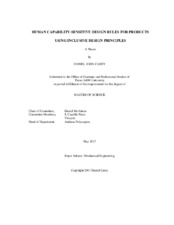| dc.description.abstract | Several design methodologies have been developed that seek to address the diverse needs of disabled users. This work reviews three such methodologies: universal design, design for all, and inclusive design. The core ideas to these methodologies are researched and explained. This work then describes a multitude of state of the art design techniques that utilize these design methodologies, and analyzes two such techniques that are readily applicable in the abstracted, functionally focused design methods that engineers commonly use.
Previous research in inclusive and universal design has led to several sets of inclusive design rules and guidelines. These guidelines suggest modifications to products, environments, and services that could lead to more inclusive redesigns. It would be very beneficial to apply these design guidelines in the initial concept generation process to develop inclusive products; as current accessible design methods rely on expensive specialized modifications to typical products. Preliminary research into these inclusive design rules, and their underlying design representation scheme, has shown that these rules and methods are useful in designing inclusive architectural products. Here, architectural products are defined as products and environments for which the space around the product is important for inclusive design. This work seeks to supplement previous research, and analyze the effectiveness of these design rules when applied to consumer products (i.e. products for which product usability is very important to inclusive design).
This work analyzes sets of inclusive design rules; first by observation, followed by an in-depth case study testing each design rule on a product that was originally designed for users without disabilities. These case studies analyze how inclusive design rules affect products, and what modifications these inclusive design rules lead to. We then study potential users’ and experienced designers’ opinions regarding the inclusivity of these products in order to gain insight on the effectiveness of the related design rule. The design rules are further analyzed in a second validation study. This validation study tasks participants with redesigning typical products using the given design rules. We analyze how the participants apply the design rules, and what effects they have on product inclusivity. | en |


